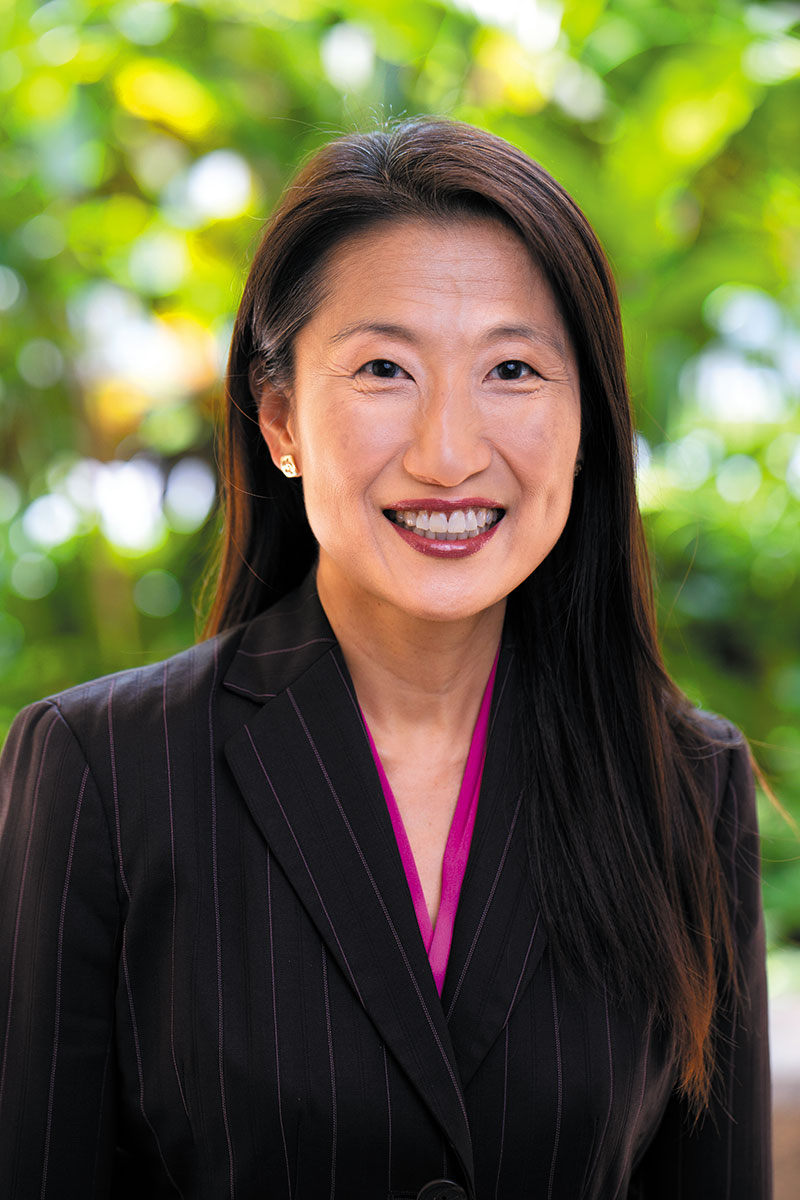Full Speed Ahead

Hawaiian Telcom’s top executive Su Shin is moving as fast as she can to meet the growing demand for broadband service across the state.
The story of Su Shin is about speed, or more specifically, the fast-moving fiber network that seems to be on her mind a lot these days.
That’s what happens when you assume the helm of a local telecommunications company and the indispensable need for broadband speed is everywhere — in homes, in businesses, in schools, in cars.
Not that Shin would ever complain about the dizzying demand for ubiquitous service. Exactly one year after being named president and general manager of Hawaiian Telcom, she still intends to have fiber — which transmits digital information almost as quickly as the speed of light — be accessible to all.
“We’re constantly planning, engineering and building fiber,” says Shin. “We don’t have fiber to every single home and we don’t have fiber to every single business in the state today …”
But it’s coming. Patience is key, she notes, particularly at a time when so many people have become stay-at-home workers or students and might be wondering why it’s taking the fiber infrastructure so long to be fully built.

Gathering for a family celebration are (bottom row, from left) mother Chung Hee Spell, daughter Kayla and husband Dan Meisenzahl; and (top row) brother Jae, daughter Maya and Su Shin. PHOTO COURTESY SU SHIN
“I think what happens often in this day and age with our cell phones and our Wi-Fi access, is that (broadband connectivity) almost feels magical,” Shin explains. “But it isn’t magical; there’s a ton of work, a ton of planning, a ton of effort that goes into us being able to expand that fiber network.
“So, it’ll happen … I just wish it could happen way faster.”
Thankfully, Hawaiian Telcom — which continues to provide a broad range of communication and technology services, including phone, internet and TV options — is more than capable of expanding its broadband reach. Just in the past decade alone, the company has invested more than $500 million to grow its fiber network in Hawai‘i, all while deploying broadband service across 178,000 locations, which include 10,000 homes and businesses in rural areas.
Last October, for example, the company put the finishing touches on its fiber expansion project on Moloka‘i, where hundreds of homesteaders in Kualapu‘u and ‘Ualapu‘e were finally able to enjoy the benefits of digital connectivity. And buoyed by last week’s announcement of a $24 million award from the Federal Communications Commission, the company plans to increase fiber broadband service to both unserved and underserved areas across the state.

Shin is responsible for overseeing approximately 1,200 employees at Hawaiian Telcom.
PHOTO COURTESY HAWAIIAN TELCOM
All of which is good news for Hawai‘i’s speed-conscious consumers.
“The immediate challenge ahead for us is how we can move more quickly to deploy fiber to more communities, to more residences, to more businesses,” explains Shin. “I’d say it’s both our biggest challenge and our biggest opportunity. We have to be able to get to a place where more folks have access to high-speed internet and broadband.”
hin’s rapid rise to prominent business leader in the community can best be described with her own words: nontraditional and unique.
“I didn’t envision this,” admits Hawaiian Telcom’s first female president in its 138-year history. “For me, my career path has been one of being at the right place at the right time.”
While there’s an element of good fortune to her story, it’s also true that Shin brought her own set of qualifications to the job. Beyond her ability to effectively communicate with others, she’s also blessed with innate qualities that have served her well during her speedy ascent to the top of the telecommunications landscape. Those traits include the inquisitive and determined sides of her personality that first drove her to become a broadcast journalist in the 1990s.
“It’s my curiosity and my unwillingness to take the first answer I get,” states Shin, who some may remember from her days as a reporter at KHNL-TV.
But after a few years in the journalism field, Shin decided a change was in order. She accepted the position of senior vice president at public relations agency Bennet Group, where she learned, among other things, the value of strategic planning. Later, she served as chief communications officer at Honolulu Board of Water Supply, where she made it a point to embrace the intricacies of the entire municipal operation.
“If you don’t understand the business, you can’t be a valuable contributor,” she explains. “That’s where I really started digging into kind of the workings of the organization beyond the surface level. That’s when I realized what I really loved: problem solving, and working together with people while trying to figure out how to get from point A to point B.”
If anything, Shin discovered that she doesn’t have to be a superwoman to run Hawaiian Telcom.
To her, an effective leader doesn’t worry about being the most knowledgeable person in the room, nor does she reject assistance when others are perfectly willing to help shoulder the load.
“I’m a big believer in surrounding myself with people smarter than me,” Shin explains. “You can’t do everything yourself. When you get into a position of leadership, as much as I want to do everything, there are only 24 hours in a day. At some point, you have to trust in your people.”
Trusting her team is one of the many lessons she’s learned from a host of mentors, including the person whom she replaced at Hawaiian Telcom, John Komeiji.
“He hired me and encouraged me to expand my role beyond corporate communications into marketing, then promoted me to chief of staff when he took over as president,” says Shin, who joined Hawaiian Telcom in 2013 as its director of corporate communication. “I learned so much about leadership and
the importance of employee engagement from him, and I literally would not be here without him.”
In accepting to lead roughly 1,200 employees, Shin acknowledges that her responsibility “is big and huge.” But to her credit, she hasn’t shrunk from her obligations, and is particularly proud of how Hawaiian Telcom has navigated its way through the trials of COVID.
“We’ve prioritized caring for our employees, but have balanced that out with making sure we’ve been able to serve our community,” she says. “At the beginning of the pandemic, no one knew how this virus was spread. It was a tough balance, but I feel like we prioritized the right thing. We chose to have open and transparent communication with our employees, and whether things were bad or good, we made sure they always knew what was happening.”
hen Shin was 5, her family emigrated from Korea to Hawai‘i. Her father, only 33 at the time, had suddenly and unexpectedly died in his sleep, and as a result, her mother wanted a new start elsewhere for Shin and older brother Jae.
“My mom’s sister was living in Hawai‘i at the time, and her husband had a Department of Defense job,” Shin recalls. “They sponsored us, and that’s how we ended up here.”
The transition to the islands had its share of difficulties. For one thing, none of them spoke English.
For another, the family had very little money and would come to rely upon government assistance to make ends meet.
Shin recalls the family lived in a small apartment “across the street from Ka‘iulani Elementary School and above a TV repair shop” for some time before they were able to find residency at Mayor Wright Homes.
“I’m really the product of all of the social services that you hear about,” she says. “We had food stamps; we received welfare payments.”
Despite the financial challenges, Shin’s mother, Chung Hee Spell, was determined to have her children receive a quality education.
“Obviously, education was the top priority for her,” says Shin, adding that she inherited her creative and problem-solving traits from her mother.
Hawaiian Telcom’s top executive pauses for a moment before continuing: “Sometimes we talk about the American dream and immigration. Our story is the example of what can happen with access to education.”
Shin’s story has one more aspect that deserves brief mention, and it involves three other members of her family.
In 1997, she married Dan Meisenzahl, the former KITV news anchor and Hawai‘i Department of Transportation spokesman who now works as director of University of Hawai‘i’s Office of Communications. Despite their busy schedules and highly visible jobs, the couple — who has two daughters, Maya and Kayla — manages to find the happy balance between their professional and private lives, according to Shin.
“Dan is so amazingly supportive. Even when the kids were little, we both had really demanding careers,” she shares. “But I always felt it was an even split. You always hear people complaining, ‘Oh, my husband doesn’t help with the kids and the house things,’ but I definitely feel like we’re partners.”
One thing Shin is admittedly still coming to terms with is being an empty nester. Her daughters are students at Boston-based colleges, and whenever they’re on the East Coast, she can’t help but “miss them terribly.” But she’s grateful that today’s “wonderful communication tools” allow her to better cope with the separation.
“It’s great to be able to talk to our daughters daily, even if it’s just for short touch points like saying ‘good morning’ or ‘good night,’” she says.
Yes, even Hawaiian Telcom’s leader needs speed each day to bridge the digital divide.






